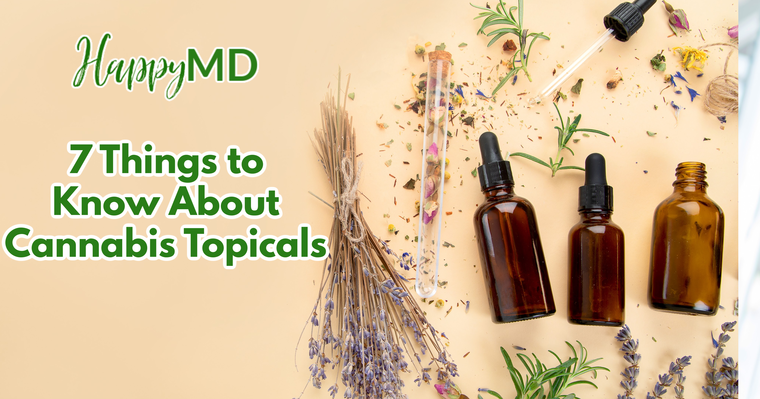
Interesting Things to Know About Cannabis Topicals
Most individuals find smokables (vape or raw flowers), edibles, or tinctures as the favorite way to consume marijuana. However, topicals are the most effective way to provide relief for patients with pain symptoms.
Are you currently using topical creams or ointments at your local dispensary over the counter? You may be thinking of switching to cannabis-infused topicals after experiencing debilitating health issues and using these products.
This article outlines seven vital things you must understand about marijuana topicals. Furthermore, you’ll learn why it's good to try a sample or a small amount of the product before purchasing. Remember, not all marijuana topicals are equal. However, finding one that alleviates your pain and makes the inflammation more bearable will be wise.
1. What are the Available Topical Products?
Many individuals consider ointment or cream when thinking of marijuana topicals. Topicals refer to a substance you can apply on a particular area of your body to alleviate a certain symptom or for wellness. Most medical dispensaries have various marijuana-infused topical products to help alleviate different symptoms.
Nevertheless, we’ve got other cannabis topicals you can take to condition your skin or body to feel more relaxed, and offers anti-inflammatory & antioxidant properties. Studies show that cannabinoids provide a wide range of health benefits after absorption.
Below are the common and effective types of marijuana-infused topicals products:
● Soaps
● Lip balms
● Bath oils
● Cosmetics
● Nail products
● Shampoo and conditioner
● Face masks
● Leave-in-hair oil
● Intimate lubricants
● Foot creams
● Hydrating lotions
Foot care is vital for individuals living with diabetes. Neuropathy may result in skin and nail changes. Diabetic individuals may have painful, dry, and cracking skin in areas with less blood flow. Using cannabis-infused diabetic foot cream will help to reduce infections and cracking by addressing skin dryness.
2. How Do Marijuana Topicals Work?
The skin absorbs topical products faster after application. In the skin, CBD binds to CB2 receptors, which are the most plentiful receptors in the layers. Besides the CB2 receptors, you can also find smaller amounts of CB1 receptors in the skin dermis.
Remember, there is usually a fast uptake of cannabinoid topical through the receptors. The receptors in the specific regions you feel or experience will uptake CBD rapidly. The rapid uptake results in a fast response and explains why CBD topicals provide localized relief. The products will offer relief in areas where you have pain and need it most.
3. Can Cannabis Topical Result in a ‘High’ Feeling?
You can become intoxicated after applying a cannabis topical, but in rare cases. Commonly, it occurs after you apply a huge volume of marijuana-infused lotion or cream on a broken skin area. The absorption usually results in mild psychoactive effects. However, most topical creams from Delta-9 THC or cannabidiol don’t cause impairment.
Most individuals refer to transdermal patches as topical, as you must apply them on the skin to be effective. It’ll be good to be cautious when using marijuana-infused patches, as the different potencies may result in impairment.
4. Have All States Legalized Cannabis Topicals?
You’ll likely get clinical-grade topicals at the nearest dispensary when living in a state with a functional medical marijuana program. The dispensary may have creams, oils, and oils with varying potencies you can use for your mild to moderate conditions.
However, you won’t access or purchase marijuana-infused topical in states that are yet to legalize medical cannabis use. Furthermore, the state authorities also restrict ordering the product online. You can still get the clinical grade CBD topicals at the local stores.
Remember, you can only find high-quality CBD topicals online or at health stores. Nonetheless, it’ll be wise to research the products, to ensure that you get the best products from a trustworthy brand. With many imposters with fake clinical-grade CBD, it’ll be wise to take time and research before choosing the appropriate and safe one.
5. What is the best Frequency of Applying Topicals?
Before considering the application frequency, it’ll be wise to start by getting the best topical with full-spectrum cannabinoids. These products can include oils and creams with CBDV, CBN, CBC, CBG, THC, and CBD. You can also consider topicals with additional herbal additives or terpenes, such as calendula oil and menthol.
Experts recommend that you have to apply most topics thrice a day. Depending on the quality of the product, you can increase or reduce the frequency. After application, always remember to rub the cream or oil for faster and rapid absorption in the skin to the CB1 and CB2 receptors.
6. After Using Topicals, Will You Test Positive For Marijuana?
Researchers have carried out various studies to address the concern of testing positive for THC or marijuana after applying topicals. The study reveals that you’ll get negative results in a urine analysis or blood test.
However, the results might be slightly different with transdermal patches. Depending on the patches’ potency, you may test positive or negative for THC.
7. Can You Use THC Topicals to Alleviate Severe Acne?
Acne may be disturbing, forcing you to try various medications, from special cleaners to over-the-counter, prescription strength to topical creams, to treat them. Due to the ugly appearance that impacts your self-esteem, you can spend a long time searching for something to help you.
Several studies reveal that CBD can be effective in removing acne. However, while using CBD to get rid of acne, ensure that you choose products with high clinical strength and potency.
In a certain study in 2007, the researchers revealed that the potency of most CBD products didn’t match the one on the label. The result was true on CBD oils that the researchers ordered online. Thus, if you’re planning on using CBD topically, ensure you go for high-quality CBD products.
Experts advise combining CBD oil with a carrier oil, such as coconut or argan, before application if you want to try it on your skin. Despite applying more oil on your skin or appearing counterintuitive, these carrier oils will increase bioavailability. Thus, the oils will help the skin to uptake more CBD oil as they’re fat-soluble. CBD works by dissolving in a carrier oil before the skin rapidly absorbs it.
After the absorption, the mixture of carrier oil and cannabidiol can help reduce psoriasis, and eczema, reduce visible facial lines and tighten pores. Remember, the numerous antioxidant and anti-inflammatory CBD properties have various internal and external benefits.
Remember to wash your hands and fingers with soap thoroughly after applying the products or topicals to your skin. Washing your hands will be vital to eliminate the natural ingredients manufacturers include in the products. When in contact with your mucus membrane, these ingredients result in a burning sensation. The burning sensation worsens upon touching your eyes, nose, and other sensitive body parts.


.png)